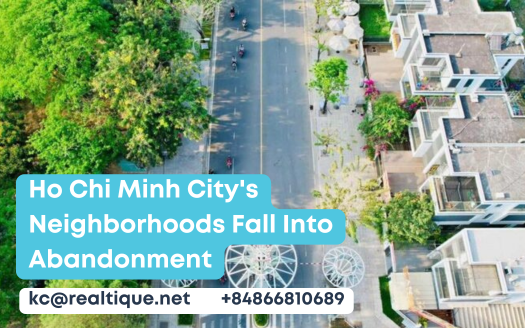Ho Chi Minh City’s Neighborhoods Fall Into Abandonment
Ho Chi Minh City is witnessing a concerning trend of urban abandonment, particularly in neighborhoods like the Dong Tang Long Urban Area, which was once envisioned as a lively community. Factors such as escalating real estate prices, inadequate infrastructure, and waning investor confidence have contributed to the deterioration of these areas. The consequences are far-reaching, as environmental neglect and declining public services leave current residents feeling increasingly isolated. Understanding the interplay of these factors is essential, and the potential pathways for revitalization may hold the key to reversing this troubling path.
Table of Contents
Overview of Dong Tang Long Urban Area Abandonment
In the sphere of urban development, the phenomenon of urban abandonment poses significant challenges for cities like Ho Chi Minh City, particularly in areas such as the Dong Tang Long Urban Area.
Established in 2005, this urban enclave was envisioned as a modern community featuring residential, commercial, and educational facilities. However, the current reality starkly contrasts this vision, with many properties lying abandoned or in disrepair.
The lack of essential infrastructure and services has rendered the area unattractive to potential residents, leading to a decline in population density. Consequently, unfinished buildings and neglected community spaces contribute to a pervasive sense of desolation, raising concerns about safety and livability.
Addressing these issues is vital for the area’s revitalization and future urban planning efforts.
Economic Factors at Play
Frequently, economic factors significantly influence the interplay of urban development, particularly in areas like the Dong Tang Long Urban Area. The disparity between property prices and living conditions has led to a stagnation in demand, hindering the area’s growth. High property costs, coupled with inadequate infrastructure, deter potential residents and investors. Below is a summary of the economic environment influencing this urban area:
| Economic Factor | Impact on Development | Current Situation |
|---|---|---|
| Property Prices | High entry barriers | Ranges from 65-70 million VND/sq.m |
| Demand for Rentals | Increased rental prices | Monthly rents around 25 million VND |
| Infrastructure Quality | Diminished attractiveness | Lacks essential services |
| Investment Climate | Low investor confidence | High speculation, low activity |
These economic challenges contribute to the area’s decline, necessitating targeted interventions for revitalization.
Although many residential properties in the Dong Tang Long Urban Area were initially constructed to modern standards, the current state of these buildings reveals significant neglect and deterioration.
The following issues are prevalent throughout the area:
Unfinished Structures: Numerous buildings remain incomplete or abandoned, compromising the overall aesthetic.
Environmental Neglect: Overgrown vegetation and waste accumulation create an uninviting atmosphere.
Interior Degradation: Many interiors are uninhabitable, plagued by mold and deteriorating facilities.
Visible Damage: Properties exhibit signs of neglect, including broken fences and crumbling walls.
These conditions have raised concerns among residents regarding safety and livability, further contributing to the area’s declining appeal and hindered potential for revitalization.
The deteriorating conditions of residential properties in the Dong Tang Long Urban Area are mirrored by significant infrastructure deficiencies that further undermine the community’s livability.
Essential public services, including security, waste management, and transportation, are glaringly inadequate. Promised facilities such as schools, hospitals, and parks remain unconstructed or are in a state of disrepair, exacerbating residents’ frustrations.
Existing community spaces, which could encourage social engagement, are neglected and contribute to an atmosphere of abandonment. Despite local government initiatives aimed at improvement, progress has been sluggish, leaving residents struggling to access basic amenities.
These infrastructure shortcomings not only diminish the quality of life but also deter potential new residents, further entrenching the area’s decline and disillusionment among its current inhabitants.
Community Challenges Faced
Numerous community challenges hinder the overall well-being of residents in the Dong Tang Long Urban Area. The lack of essential services and infrastructure has resulted in a decline in quality of life, driving potential residents away.
Key issues include:
Inadequate Public Services: Insufficient security, waste management, and transportation links leave residents vulnerable and disconnected.
Neglected Community Spaces: Parks and recreational areas are often in disrepair, diminishing opportunities for social engagement.
Unfulfilled Promises: Essential facilities such as schools and healthcare centers remain unbuilt or poorly maintained, affecting educational and health outcomes.
Diminished Population Density: As amenities decline, the community faces challenges in attracting new residents, exacerbating feelings of abandonment and isolation.
These factors collectively undermine the potential for a lively community in the area.
Prospective Development Strategies
Addressing the community challenges faced in the Dong Tang Long Urban Area necessitates the implementation of targeted development strategies aimed at revitalizing the neighborhood.
Prioritizing infrastructure improvements is vital, focusing on essential services such as waste management, security, and transportation links.
Collaborating with local stakeholders and encouraging community engagement can cultivate a sense of ownership among residents, promoting sustainable practices.
Additionally, incentivizing private investment in residential and commercial projects will help attract potential residents and businesses.
The establishment of essential amenities, such as schools and healthcare facilities, will enhance the area’s livability.
Role of Government Initiatives
Effective government initiatives play an essential role in addressing the challenges faced by the Dong Tang Long Urban Area.
To revitalize this declining neighborhood, the government must adopt a diverse approach that includes:
Infrastructure Development: Prioritize building essential services such as schools, healthcare facilities, and public transportation.
Maintenance Programs: Implement regular maintenance and waste management systems to improve the living environment.
Community Engagement: Encourage open dialogue with residents to understand their needs and involve them in decision-making processes.
Incentives for Investment: Create financial incentives for developers to invest in and rehabilitate abandoned properties.
Through these initiatives, the government can not only restore the area’s attractiveness but also enhance the quality of life for its residents.





